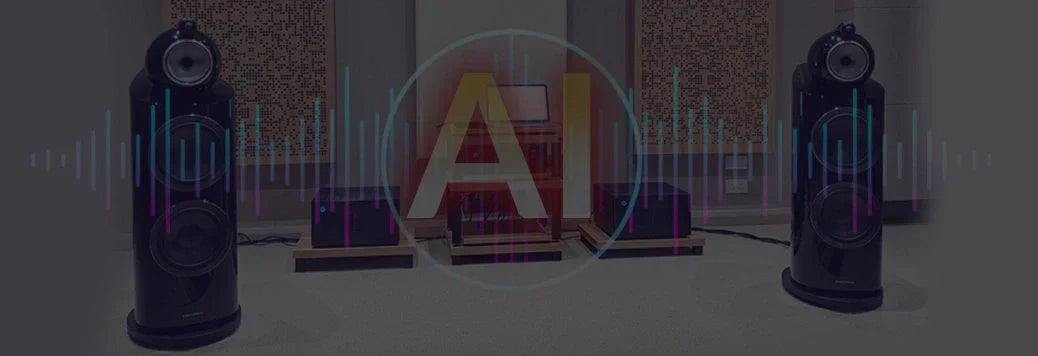Imagine this: you're watching a film at home, and without you lifting a finger, the sound seems to shift and shape itself perfectly to your room. The dialogue is clear, the background score swells just right, and when something explodes on screen, you feel it—no manual tweaking, no messing with settings.
This is the promise of AI-driven audio algorithms. They’re quietly transforming the way sound systems behave, especially in setups where the hardware—your speakers, amps and processors—is already top-tier. These algorithms act like an invisible hand, shaping the audio on the fly so that it fits your space, your content and your preferences. It’s not just about better sound anymore—it’s about sound that knows you.
What Are AI-Driven Audio Algorithms?
At their core, they’re not just fancy DSPs or another layer of EQ. AI audio algorithms are built to listen, learn and respond. Instead of relying on static settings, they adapt. Let’s say your room has hard surfaces or a lot of open space. The system picks up on that using its mics, then adjusts the audio—things like timing, EQ curves, even which speakers are emphasised—to give you a more balanced result.
They also react to content. If you’re watching a thriller with whisper-quiet dialogue and sudden booms, the algorithm reads the shifts and reshapes the sound accordingly. Some even track your behaviour over time—how loud you like it at night, or what tweaks you always make for music—and they start making those changes for you. Over time, they even learn from your habits and preferences, fine-tuning playback to match the way you listen. The result? Personalised audio that feels immersive and finely tuned—something that once only existed in high-end studios or live sound rigs.
Why Does It Matter in a High-End Setup?
You’ve already spent serious money on great gear—maybe it’s a set of reference-grade speakers, a powerful amp or a high-end DAC. So it’s easy to think, “That’s it, I’ve hit the ceiling.” But here’s the catch: even the best equipment can underperform if your room doesn’t cooperate. Maybe the acoustics are tricky, or your system just doesn’t adapt. That’s exactly where AI-driven audio steps in—bridging the gap between great hardware and a truly dialled-in listening experience. These systems adapt in real time to correct room-related issues like echoes or standing waves, tweak playback if your seating position changes, and even shape the sound to match what you’re watching or listening to. Instead of a one-size-fits-all sound, you get a system that feels dialed in for every track and every scene, no matter the room or occasion.
How AI Is Already Shaping High-End Audio

Image credit - Forbes
So where is this tech actually being used today? Let’s break it down:
-
Real-time Room Tuning
Some systems—like those powered by Dirac with Bass Control—don’t just calibrate once and call it a day. They listen to the room in real time, constantly adjusting the way sound is distributed.
Benefit: Clearer, more balanced audio for everyone in the room, not just the person parked in the sweet spot. -
Smarter Content Awareness
High-end processors are getting better at recognising what you’re playing. Watching a blockbuster, firing up a game or streaming a live gig? Your system knows—and adjusts dialogue intelligibility, soundstage width and low-frequency impact on the fly to match the mood and dynamics of what’s on screen or stage. The algorithm adjusts
Benefit: The system understands and enhances content type automatically -
Multi-Zone Intelligence
In luxury homes with multiple AV zones, AI algorithms ensure that each space has optimised output without user intervention. For example, your kitchen may get crisp background music while the media room delivers bombastic LFE.
Benefit: Uniformly excellent audio quality across zones -
Voice Optimisation and Dialogue Clarity
Some AI processors isolate voice frequencies in real time to enhance clarity—especially useful in content where background scores drown out speech.
Benefit: Enhanced intelligibility without cranking up the volume
How Do AI-Driven Audio Algorithms Adapt to Different Content Types?
Not all content demands the same sonic treatment. A quiet indie film, a thunderous Marvel blockbuster and a live jazz concert all have distinct audio signatures. AI-driven audio algorithms can analyse the type of content being played—detecting dynamic range, vocal intensity or soundstage requirements—and adjust playback parameters accordingly.
For example:
-
For movies, they may enhance spatial effects and low-end punch.
-
For live concerts, they prioritise stereo imaging and crowd ambience.
-
For podcasts or dialogue-heavy shows, they boost midrange clarity and reduce background hiss.
This content-aware tuning creates an immersive sound system that intelligently serves both spectacle and subtlety.
Can AI Algorithms Help Solve Room Acoustic Challenges?
Room acoustics can make or break a home audio setup. Even with high-end gear, issues like echo, dead spots or overly boomy bass can throw off the sound. That’s where AI-driven algorithms come in. Using built-in microphones or external calibration tools, they analyse the acoustic space in real time, spot problem areas like reflections or standing waves, and make instant adjustments. EQ, delay, phase and even crossover settings are fine-tuned automatically to suit the actual room. It’s like having an acoustic expert on hand—one that works quietly behind the scenes to ensure every corner of the room gets clean, balanced sound.
AI vs Traditional DSP: What’s the Real Difference?
Digital Signal Processing (DSP) has long been part of AV. But here’s the distinction:
| Feature | Traditional DSP | AI-Driven Audio Algorithms |
| Adaptability | Static, requires manual tuning | Dynamic, self-adjusting |
| Learning Capability | None | Learns from room, user & conten |
| Personalisation | Limited | Highly personalised |
| Calibration Frequency | One-Time | Continuous |
| Content Awareness | Absent | Recognises and adjusts to content |
While DSP is rule-based, AI-driven audio algorithms are predictive, responsive and evolving.
Technologies Powering This Revolution
Some of the leading AI-enabled sound technologies include:
-
Dirac Live AI: With room learning and bass control modules
-
Yamaha’s YPAO 3D + AI: Combines 3D surround analysis with scene recognition
-
Sony’s 360 Reality Audio: Maps listener head position using AI to create spatial realism
-
Denon’s HEOS AI: Adjusts multi-room playback patterns and audio focus
These aren’t gimmicks—they’re rapidly becoming standard in immersive sound systems across premium home theatres and studio-grade listening rooms.
Is AI Making Audio More Personalised Than Ever?
Absolutely—and this is where things start to get really interesting. AI algorithms are now learning how you listen. Over time, some systems begin to recognise your habits—like which volume level you use for movies versus music, or how you adjust settings during certain genres. A few high-end soundbars and AV receivers even allow individual users to create custom audio profiles. So whether you’re someone who enjoys deep bass and crisp highs, or you prefer a neutral tone with a focus on dialogue, AI steps in to shape the sound around your preferences. It’s no longer just smart—it’s personal.
Future Potential: Where Is This Headed?
The potential is vast:
-
Emotion-Aware Audio: Algorithms that respond to facial expressions or heart rate to adjust intensity
-
Dynamic Seating Mapping: Real-time tracking of listener position for perfect surround imaging
-
Cross-Platform Learning: AI that learns your habits across platforms (Spotify, Netflix, PS5) and adjusts accordingly
With edge computing and embedded AI chips growing more powerful, expect these features to become integral to AV experiences.
Final Thoughts: Sound That Thinks With You
As home theatres evolve from static setups to intelligent, sensory environments, AI-driven audio algorithms are becoming the invisible conductor—tuning, shaping and perfecting every moment of your AV experience.
For discerning users who demand more than just volume and clarity—for those who want a truly immersive sound system that’s alive and aware—this is the future.
Explore Ooberpad’s range of AI-enhanced AV components and consult our specialists to build a system that doesn’t just play sound—it understands it.







